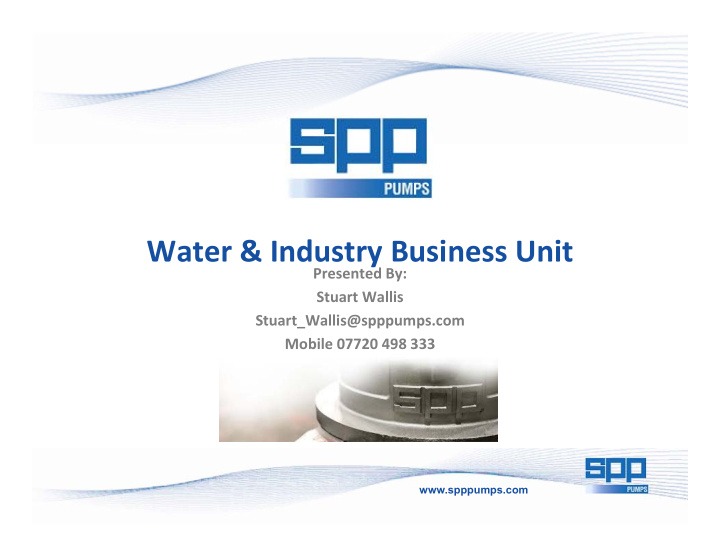



Water & Industry Business Unit Presented By: Stuart Wallis Stuart_Wallis@spppumps.com Mobile 07720 498 333 www.spppumps.com
Agenda • Introduction • SPP • Our design ethos • Centrifugal pumps types and construction • Centrifugal impeller types • Centrifugal pump curves • Information needed for selection (WIMES datasheets) • Pump & system interaction • Why we need to select the pump at its BEP • Any questions www.spppumps.com
Brief History of SPP Pumps Over 140 years of experience & expertise 1875 – Founded as Pulsometer Engineering. 1901 ‐ Moved from London to new premises in Reading, UK. 1961 ‐ Joined Sigmund Pumps of the UK and became known as Sigmund Pulsometer Pumps, SPP for short. 1986 ‐ All UK manufacturing moved to Coleford 2003 ‐ Present SPP was acquired by our current parent company, Kirloskar Brothers Limited (KBL). www.spppumps.com
Pump design – our ethos • Developed for the water utility market • 21 st century commercially aware end users • To cover the majority of applications • Highly evolved ‐ not a new product • Benefits pre & post installation • Highest quality & longevity • Greatly reduced energy cost • Very reliable • Minimised performance degradation www.spppumps.com
Types of centrifugal pumps single stage End suction, split case, vertical turbine pumps Types of two stage End suction, split case, vertical turbine centrifugal pumps pumps Three + multistage pumps, vertical turbine stage pumps Can be mounted vertical or horizontal Except the vertical turbine pumps www.spppumps.com
How does a centrifugal pump work • Fluid enters the impeller at its axis (the ‘eye’) and exits along the circumference between the vanes. • The impeller, on the opposite side to the eye, is connected through a drive shaft to a motor and rotated at high speed (typically 750 ‐3000rpm). • The rotational motion of the impeller accelerates the fluid out through the impeller vanes into the pump casing. • The purpose in this pump design is to translate the fluid flow into a controlled discharge at pressure. • In a volute casing, the impeller is offset, effectively creating a curved funnel with an increasing cross‐sectional area towards the pump outlet. This design causes the fluid pressure to increase towards the outlet www.spppumps.com
Efficiency Stainless Steel Serrated Wear Double Row Thrust Impeller Enhancing Impeller Ring Bearing Lock Nuts Coating Throttle Bush Stainless Steel Shaft Short Bearing Span Externally Removable Bearing Housing
LLC Split Case Range Chart
Additional product ranges & services • End suction • Long coupled and close coupled • Multistage pumps • Variety of materials • Horizontal or vertical • Booster sets • PaT ‐ pumps as turbines • For hydro power generation www.spppumps.com
Types of impellers Closed‐impellers are the most efficient type of radial flow impeller, Radial flow as flow is directed through the channels between the impeller vanes. impeller Types of Mixed flow They can be used on relative high flow with medium head Impellers impeller requirements. Axial flow Used on low head large flow applications impeller www.spppumps.com
Centrifugal pump curves www.spppumps.com
www.spppumps.com
Pump and System Interaction What are we looking to achieve with pump station design? to deliver the required volume of liquid using the minimum amount of energy. pumps operating with greater reliably and in turn requiring less maintenance and fewer call outs to pumping stations. Why is this not always possible to achieve? Incorrect pump specification Errors in pumping station design Inadequate pump control www.spppumps.com
Errors in Pump Station Design How can we ensure we eradicate this aspect ? early engagement with pump suppliers. provide all the available information to allow a better understanding of what the pump is being asked to perform – WIMES datasheets What information do the pump suppliers need? all the required duty parameters utilisation full details on media being pumped system information www.spppumps.com
System Information • What does the system information comprise of? • Relates flow to head • Comprises static and friction losses • Takes account of any varying static • Incorporates common main losses, including process equipment • Generally excludes station losses associated with individual pump suction and delivery pipework – losses subtracted from pump curve • Pump curve can be added • How does this relate to the selection of the pump? The system curve www.spppumps.com
Factors affecting friction loss • Flow velocity • Pipe diameter • Number of pipes – parallel mains • Pipe material • Pipe age • Type of fitting • Liquid viscosity • Velocity/diameter and pipe materials have a major effect on pump selection and power requirements www.spppumps.com
Inadequate pump control • We advise that variable speed control be used when you have one or more of the following conditions: • wide range of system head • variable flow required • run out problems at solo operation in parallel pump systems • uncertainty over system head • need to optimise running costs • suitable pump running at synchronous speed not available www.spppumps.com
Incorrect Pump Selection Why do we see poor pump selection Not selected to operate at or near to BEP over the entire operating range required Not the best pump type for the application Insufficient system information to make the best choice of pump www.spppumps.com
Hydraulic Deterioration SPP Water Division – Waste Water Pump Original BEP Head/Flow Flow Reduces = More Hours Run Efficiency Loss = More Power Deteriorated Efficiency Deteriorated www.spppumps.com
Thank You www.spppumps.com
Recommend
More recommend